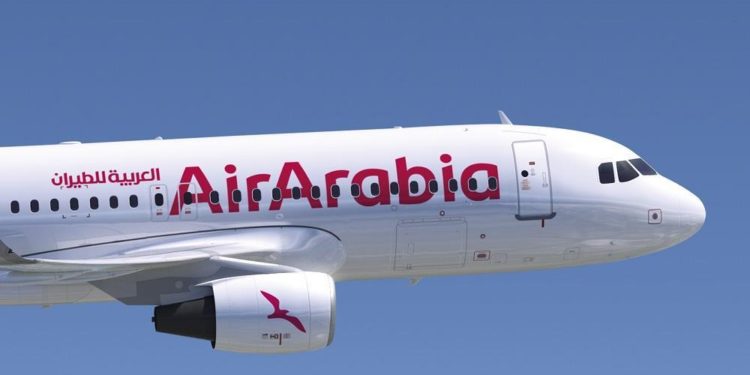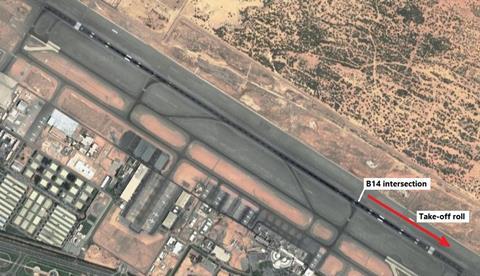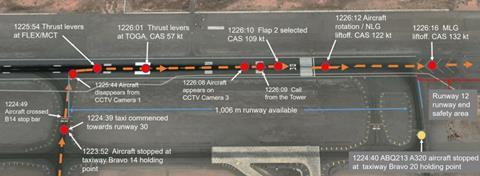Airbus A320 Overran on Take-Off After Wrong-Runway Error

United Arab Emirates investigators have disclosed that an Air Arabia Airbus A320 lifted off beyond the end of a Sharjah runway after the captain opted to continue a take-off despite the jet’s turning onto the wrong runway for departure.
The Airbus A320 aircraft — bound for the Omani city of Salalah, with a trainee first officer flying — had been cleared to depart from runway 30 but, from the B14 intersection, the crew turned onto the opposite-direction runway 12 and accelerated into a rolling take-off.
Although the aircraft was traveling at just 63kt groundspeed, the captain — having realized the jet was heading in the wrong direction — believed there was insufficient runway distance to abort the take-off, and advanced the thrust levers to full power. Analysis by the General Civil Aviation Authority found there was 730m of runway available at the time.
Tower controllers contacted the crew, after noticing the Airbus A320 was rolling along the wrong runway, but there was no response
The captain deployed additional flap and initiated rotation with aft sidestick input, although the first officer was simultaneously applying a nose-down input she had maintained since the beginning of the take-off roll.
Investigators state that the aircraft overran the far end of runway 12 by 30m, entering the runway safety area, before lifting off at 132kt. One of its main landing-gear tires struck and damaged an approach lamp.

Source: Google Maps with FlightGlobal annotation.
After turning right, instead of left, at the intersection the aircraft was lined up on runway 12
None of the 42 passengers and six crew members was injured during the September 18, 2018, event, and the flight proceeded safely to its destination.
The inquiry says the first officer had been under multi-pilot license training, and had accumulated 160h on type. She had progressed sufficiently to assume the responsibilities of flying pilot without the need for a cover pilot in the cockpit. The captain had over 15,500h on type from a total of more than 22,000h.
Airbus performance calculations and simulations found that the aircraft (A6-ANV) would have been able to stop safely on runway 12 if the captain had executed a rejected take-off
According to the captain, he had been completing the
“before take-off” checklist and did not realize the aircraft had turned onto the wrong runway.

Source: GCAA. Key points during the A320’s short-field departure and overrun at Sharjah.
The inquiry says a “lack of external peripheral visual watch” by the pilots, as well as a failure to confirm the runway, led to the incident.
Even though the carrier had prevention barriers in place, such as positive runway identification, critical elements were “probably missed,” the inquiry added.
Home-base habitual behavior might have played a role — the first officer had carried out three prior departures from runway 12 — and the inquiry says the captain’s decision to carry out a single-engined taxi, when the taxi time was short, could have increased the crew’s workload.
Source: Flight Global, “Air Arabia A320 overran on take-off after wrong-runway error,” David Kaminski-Morrow, January 11, 2022.
Circumstances can crop up anywhere at any time if proper and safe sequence and procedures are not planned and followed. We encourage you to learn and use the TapRooT® System to find and fix problems.
TapRooT® has a team of investigators and instructors with years of extensive training ready to offer assistance worldwide. We also offer ongoing support to our clients through free newsletters and root cause tip videos, the root cause analysis blog, and our annual Global TapRooT® Summit.
Register for one of our courses. We offer a basic 2-day course and an advanced 5-day course. Contact us or call 865.539.2139 about having a course at your site or for further root cause analysis opportunities. We’re here to find solutions for you.
Contact us to discuss training your employees on-site. You may also call us at 865.539.2139 to speak to an instructor, schedule an executive briefing, or book on-site training for your team.



